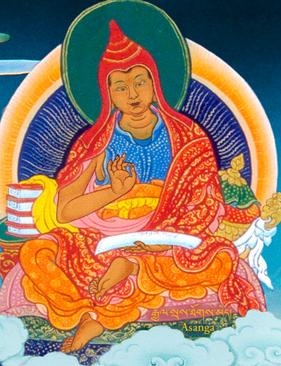Compendium of Abhidharma: Difference between revisions
Jump to navigation
Jump to search
No edit summary |
mNo edit summary |
||
| Line 1: | Line 1: | ||
[[image:Asanga.JPG|frame|'''Asanga''']] | [[image:Asanga.JPG|frame|'''Asanga''']] | ||
The '''Compendium of Abhidharma''' (Skt. ''Abhidharmasamuccaya''; Tib. [[མངོན་པ་ཀུན་བཏུས་]], | The '''Compendium of Abhidharma''' (Skt. ''Abhidharmasamuccaya''; Tib. [[མངོན་པ་ཀུན་བཏུས་]], Wyl. ''mngon pa kun btus''; Tib. ''ngönpa küntü'') was composed by [[Asanga]], one of the '[[Six Ornaments]]', the greatest Buddhist authorities of Ancient India. ''Abhidharma-samuccaya'' is a complete and systematic account of the [[Abhidharma]]. It is included among the so-called "[[Thirteen great texts]]", which form the core of the curriculum in most [[shedra]]s and on which [[Khenpo Shenga]] provided commentaries. | ||
Revision as of 20:30, 27 January 2017

The Compendium of Abhidharma (Skt. Abhidharmasamuccaya; Tib. མངོན་པ་ཀུན་བཏུས་, Wyl. mngon pa kun btus; Tib. ngönpa küntü) was composed by Asanga, one of the 'Six Ornaments', the greatest Buddhist authorities of Ancient India. Abhidharma-samuccaya is a complete and systematic account of the Abhidharma. It is included among the so-called "Thirteen great texts", which form the core of the curriculum in most shedras and on which Khenpo Shenga provided commentaries.
Commentaries
- Khenpo Shenga, ཐེག་པ་ཆེན་པོའི་ཆོས་མངོན་པ་ཀུན་ལས་བཏུས་པའི་མཆན་འགྲེལ་ནོར་བུའི་མེ་ལོང་
Translations
- Asanga, Abhidharmasamuccaya: The Compendium of the Higher Teaching (Philosophy), translated by Walpola Rahula, Sara Boin-Webb, Asian Humanities Press, 2001
Internal links
Further Reading
- Dan Martin, 'Gray Traces: Tracing the Tibetan Teaching Transmission of the mNgon pa kun btus (Abhidharmasamuccaya) Through the Early Period of Disunity' in Helmut Eimer and David Germano (ed.), The Many Canons of Tibetan Buddhism, Leiden: Brill, 2002